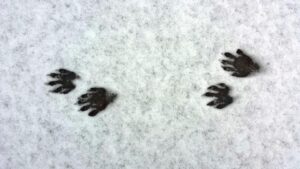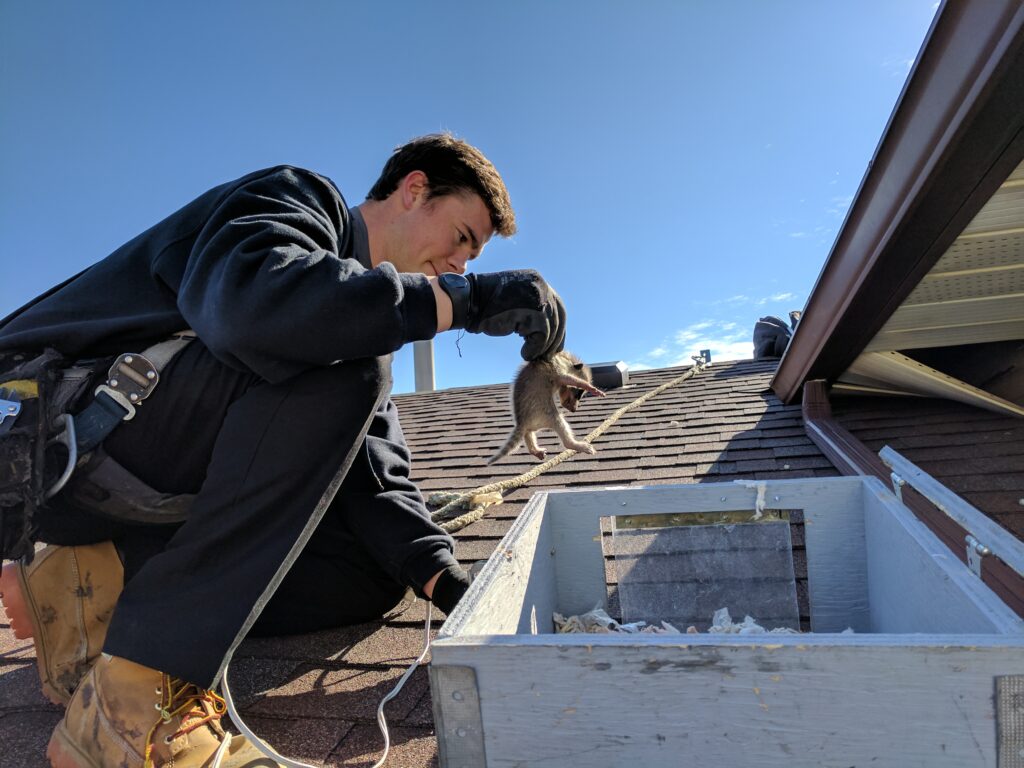As the frost takes over the landscape and we begin to bundle up inside our warm homes, we’re not alone in adjusting to the winter months. Raccoons, one of the most common wildlife species found nationwide, have unique habits and habitats during the cold period. Through this blog post, we’ll give you a closer insight into the winter behavior of our masked furry neighbors – the raccoons.
We’ll explore the winter habits of these masked animals and their winter habitats, helping you understand why you might have more encounters with them during the chillier months. In addition, we will provide signs that these animals may have become a problem around your Minneapolis property during winter.
This blog doesn’t just stop at identifying the problem; it extends to presenting solutions. You’ll learn how a professional wildlife technician can assist you in managing them on your property during winter, with a specific spotlight on understanding ‘how to get rid of raccoons‘ humanely and effectively.
What are the Typical Winter Habits of Raccoons?
As temperatures start to drop, you might think raccoons would hibernate like other animals. Surprisingly, they don’t truly hibernate, but they do tend to “hole up” in their dens and become less active during severe weather. This is a state known as torpor.
During this period of torpor, raccoons rely on the fat reserves they’ve built up during warmer months to survive. It’s not unusual to spot these critters out and about on milder winter days, searching for extra sustenance to supplement their fat reserves.
- Food Scavenging: Known for their scavenging ways, raccoons are still on the prowl for food in winter, although their diet changes. They’ll look for easily accessible sources of nourishment, like unsecured trash bins or pet food left outdoors.
- Dens in Residential Areas: They prefer to den up higher, like in attics or chimneys, especially during the winter, so they might be closer than you think!
- Nocturnal Behaviour: Raccoons are primarily nocturnal creatures, so they might go unnoticed during the winter since they are active when most people are huddled indoors.
Understanding these habits can help you identify if you have a raccoon problem and enact proper wildlife control in Minneapolis.
What is the Winter Habitat of Raccoons?
During the winter, the habits and locale of these creatures significantly change. This is primarily due to their need to find warmth and food. Familiarizing yourself with these changes is critical if you hope to effectively implement wildlife control during this season.
Dens
Raccoons typically seek out dens during the winter months. These dens are essentially their winter homes that provide them with much needed warmth and protection from the harsh weather. Often, you’ll find them tucked away in hollow trees, fallen logs, rock crevices, and sometimes, unfortunately, in your attic or chimney. Given their adaptable nature, they can make their habitat in virtually any snug and cozy structure.
Food and Diet Change
In preparation for winter, raccoons tend to change their diet. While they’re typically known to be omnivores, their preference during the cold months shifts towards plants and berries. This is due to the scarcity of insects and smaller creatures, their other main food sources, during winter. However, undeterred by their diet change, these creatures are open about rummaging through your garbage cans or outdoor pet food dishes if food is scarce.
Understanding these shifts in their winter habitat and habits can help you identify signs that they might be creating a nuisance around your home. This is the first step to figuring out how to get rid of raccoons.

What are the Signs that Raccoons are a Problem During the Winter?
Understandably, the winter season brings a unique set of challenges for homeowners dealing with raccoons. Despite their adorable appearance, these creatures can create substantial hassles if they choose your house as their winter habitat. Below are some telltale signs indicating animals are causing winter problems.
- Frequent Noises: Raccoons are nocturnal, so if you hear scratching, growling or other strange noises in your attic or walls during nighttime, this could be a clear sign of them homesteading. Besides these sounds, you might also notice a distinctive smell resulting from their urine, feces, or even a deceased animal trapped in your living space.
- Property Damage: These animals are known for their curiosity and dexterity, which can lead to visible damages like torn roof vents and broken soffits as they try to gain access to warmth during cold winter days. In addition, they can often leave tell-tale signs of their presence, such as distinctive, paw-shaped tracks in the snow around your property.
- Tracks and Droppings: Raccoons have quite distinguishable paw prints. If you notice such tracks around your property, it may indicate their presence. Similarly, their droppings can be found near their living area, clearly indicating an infestation. Finding these signs promptly can help address the issue before it escalates into a full-blown infestation, potentially causing more damage to your property.
In our line of work, these signs also provide clues about their entry point and can guide us in formulating an effective removal plan. Remember, dealing with these critters should be left to the professionals. We deeply understand raccoon habitat and their habits, and we care about humane removal.
How Can a Wildlife Technician Effectively Control Raccoons During the Winter?
Any encounter with wildlife can be interesting, but uncovering a family of raccoons in your attic during the icy winter months can frustrate even the most patient homeowner. The crucial solution here is not in how to get rid of them yourself. Rather, the ideal remedy involves enlisting trained wildlife control in Minneapolis. A skilled wildlife technician can help control animals effectively during winter.
Methods of Raccoon Control
Humane yet effective strategies are indispensable for managing the raccoon’s presence. The first approach is exclusion. Technicians identify how these critters gain entry into your home and install special devices that allow the wildlife to leave but not return. Following the eviction, securing the space prevents new ones from moving in. This includes sealing all potential entry points and removing enticing food sources.
Knowledge of Raccoon Winter Habitat is Key
While these methods may seem straightforward, they do necessitate a sound comprehension of raccoon behavior and habitat. In warmer months, they are generally comfortable in wooded areas that provide easy access to water. However, when winter comes, these intelligent creatures scout for warmer spots – like your attic. Understanding patterns like this enables us to anticipate and prevent infestations.

What are the Benefits of Hiring a Professional Wildlife Removal Service?
Hiring a professional removal service, such as ours, brings an array of benefits that not only aid in the immediate removal but also in preventing future invasions. Especially in the winter, leaving this task to professionals guarantees the quickest and safest solution to your wildlife woes.
- Expert knowledge: Our experienced technicians know exactly what signs to look for, where to look, and how to interpret the often subtle indications of a raccoon’s presence. This expertise extends beyond identification to understand their winter habits and habitats, enabling a targeted and efficient removal process.
- Proven methods: Unlike DIY attempts, our professional service employs tried-and-tested methods to ensure the humane and effective removal of these animals from your property. Combining experience and science, we can effectively respond to each unique situation’s complex challenges.
- Safety: Raccoons can be carriers of various diseases, such as rabies, making them a potential health risk. A professional service is equipped with protective gear and immunizations, ensuring safe handling and removal of these animals.
- Prevention measures: Beyond removal, our comprehensive service includes implementing preventive measures and conducting an extensive cleanup, removing the animal’s scent, which could attract other raccoons.
In the cold winter months, they seek refuge in warm, secure locations. Unfortunately, this can mean your home. But with professional wildlife control, the problem can be effectively managed without causing harm to them or disrupting your daily routine.
Skedaddle Humane Wildlife Control: Your Raccoon Solution
When faced with the question of how to get rid of raccoons, the answer is Skedaddle Humane Wildlife Control. Our team consists of experienced and trained technicians who understand the complexity of dealing with wildlife, especially in the winter. We take pride in providing a humane and professional service, prioritizing the safety and well-being of both the wildlife and our customers.
So, take the worry out of winter wildlife issues and contact us to request a quote and learn more. With our extensive knowledge of habitats and practices, we are confident in providing the best solution to your raccoon issues.

Why Enlist Professional Help?
By using professional wildlife control, homeowners can often avoid direct run-ins with these masked animals. Our team has honed their abilities to not only effectively eliminate current infestations but also deter future ones. This expertise goes beyond ‘how to get rid of raccoons’—it’s about providing a long-term solution that protects your home and the local wildlife.
The main takeaway here? Don’t let the winter habits and habitat of raccoons in Minneapolis disturb your peace of mind. Contact us today to request a quote to learn more about how our solutions can help you stay wildlife-free this winter.




